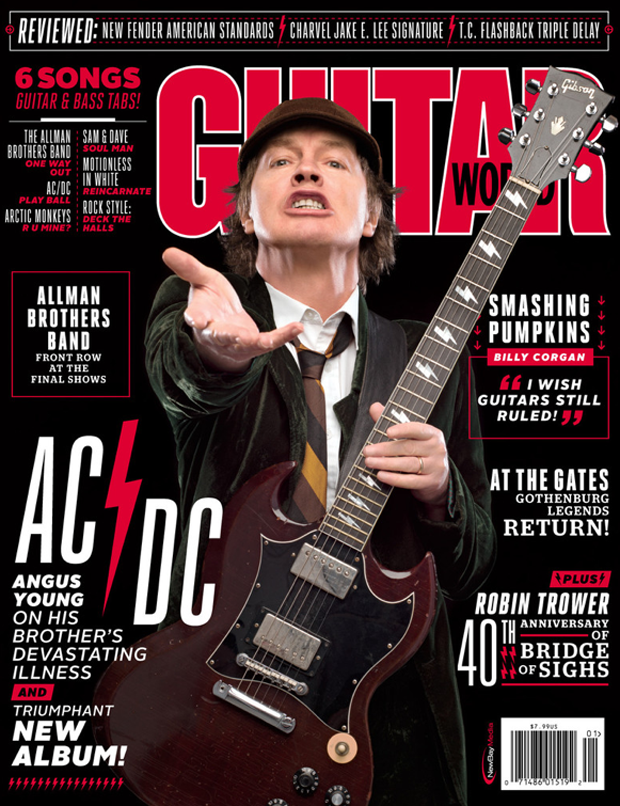AC/DC's Angus Young Discusses Malcolm's Dementia and Their Hard-Hitting New Album, 'Rock or Bust'

This is an excerpt from the all-new January 2015 issue of Guitar World. For the rest of this story, plus features on the Allman Brothers, Smashing Pumpkins and At The Gates, not to mention gear reviews, lessons and tabs, pick up the January 2015 issue of Guitar World.
Forever Young: Sidelined by illness, Malcolm Young was the heart and soul of AC/DC. But his bandmates rock on with nephew Stevie Young and a brand-new album, Rock or Bust.
“It was pretty hard,” Angus Young says about making the band’s new album, Rock or Bust. “I was doing a lot on my own.”
Speaking from the Netherlands, where his wife’s family lives, AC/DC’s lead guitarist and eternal schoolboy sounds a bit more grave than usual, just a shade or two less whimsical.
Throughout AC/DC’s 41-year history, Angus always wrote and recorded the band’s albums in close collaboration with his elder brother, Malcolm, whose monumentally solid rhythm guitar playing and gift for playfully dirty lyrical innuendo has been the band’s backbone. But when Malcolm fell victim to a debilitating condition that was recently diagnosed as dementia, Angus found himself alone at the helm of a band that has become a much revered rock and roll legend.
“Especially for guitars, Mal was always my best critic,” Angus says. “No matter what producer we worked with, I always looked to Mal at the end if I played a guitar solo or a little break here and there. And he was always the one to say ‘yea’ or ‘nay.’ ”
Rock or Bust hits as hard and burns as nasty as any other record in AC/DC’s deep catalog of thunderous rock anthems—and that is a testimony to Angus’ perseverance and AC/DC’s deathless determination to tear the roof off any studio or stadium they happen to inhabit, come hell or high water. After all this is a band that not only survived the demise of its original lead singer, Bon Scott—who boozed himself to death in 1980—but also achieved even greater glory with salacious squealer Brian Johnson as its frontman.
Much credit for Rock or Bust’s authentic crunch and swagger is due to the band’s new rhythm guitar man, Stevie Young, nephew to Angus and Malcolm. Stevie locks up seamlessly with Angus, marshaling massive slabs of power-chord muscle that support Angus’ stinging leads and skittering counter-rhythms like the rock-hard foundation of some towering skyscraper.
“Mal’s are some big shoes to fill,” Angus says. “But Stevie was always the obvious choice to take on the role. Mal and I had a kind of psychic connection going on from playing together all these years. With Stevie, we had to work things out a bit more. But he understands the way Mal would do it. And he’s got some suggestions of his own.”
Understanding “the way Mal would do it” was an essential factor in keeping AC/DC’s rock-and-roll train rolling on the right track. “Malcolm’s always been a strong presence in the band,” Angus says. “He formed the band. It was his brainwaves that put it all together. He kind of guided us from the beginning. So it is a big thing to try and keep going. And for as long as he could make his voice felt, Malcolm always said, ‘Well, you lot carry on.’ ”
Dementia is extremely rare in people under the age of 65; Malcolm is just 61. The disease severely and permanently impairs a person’s ability to think clearly, to where even routine tasks become difficult.
“I noticed the signs for a number of years,” Angus says in retrospect. “Mal got a little disconnected when we were making our previous album, Black Ice. The tour after that was difficult. And in hindsight, I realize I was noticing things even before then. But it was hard to figure out what it was, strange as that seems. It was very hard to get a diagnosis—what he actually had. He’s not an old person.”
The diagnosis, when it did come, was challenging on a personal level for the Young family. “With the condition itself, you know it’s not him,” Angus says of his brother’s affliction. “I know his wife kind of feels that way. It’s like she’s lost her husband.”
And on a professional level, the situation was also extremely difficult. Official communications regarding Malcolm’s condition were evasive at first, coupled with a plea to respect his and the family’s privacy. AC/DC’s 40th anniversary, in 2013, slipped by more or less uncelebrated. Plans for a follow-up album to 2008’s Black Ice were relegated to the back burner. “We were kind of hoping that Malcolm would get better,” Angus says. “We kind of delayed on that, not knowing.”
For a period of several years, AC/DC’s future seemed uncertain at best. “Typically at the end of every tour, we go our separate ways and decompress,” says Cliff Williams, the band’s longtime bassist, speaking from his home in Florida. “But it was on my mind certainly—the possibility that we wouldn’t do it anymore. So I was really glad when Ang called and said he was ready to do something. I was really happy about that. All of us in the band got the call to see if we were up for it, and we were. Stevie was the obvious choice to replace Malcolm. He fits in really well.”
In a sense, the game plan for a Malcolm-less AC/DC was already in place. Back in 1988, Stevie took his uncle’s place on tour with AC/DC, while Malcolm dealt with alcohol problems. “It was Mal, actually, who brought Stevie in at that time,” Angus recalls. “He said, ‘I’ll get Stevie to fill in.’ So Stevie has got a good feel for who we are playing live, which helps.”
Photo: Christie Goodwin/Redferns/Getty Images
For the rest of this story, plus features on the Allman Brothers, Smashing Pumpkins and At The Gates, not to mention gear reviews, lessons and tabs, pick up the January 2015 issue of Guitar World.

Get The Pick Newsletter
All the latest guitar news, interviews, lessons, reviews, deals and more, direct to your inbox!
In a career that spans five decades, Alan di Perna has written for pretty much every magazine in the world with the word “guitar” in its title, as well as other prestigious outlets such as Rolling Stone, Billboard, Creem, Player, Classic Rock, Musician, Future Music, Keyboard, grammy.com and reverb.com. He is author of Guitar Masters: Intimate Portraits, Green Day: The Ultimate Unauthorized History and co-author of Play It Loud: An Epic History of the Sound Style and Revolution of the Electric Guitar. The latter became the inspiration for the Metropolitan Museum of Art/Rock and Roll Hall of Fame exhibition “Play It Loud: Instruments of Rock and Roll.” As a professional guitarist/keyboardist/multi-instrumentalist, Alan has worked with recording artists Brianna Lea Pruett, Fawn Wood, Brenda McMorrow, Sat Kartar and Shox Lumania.

